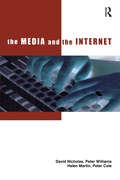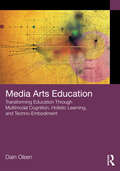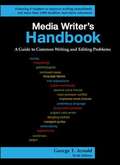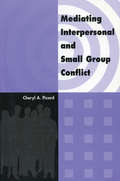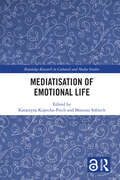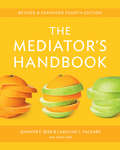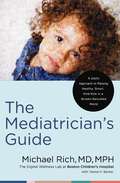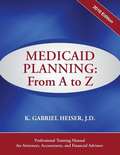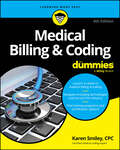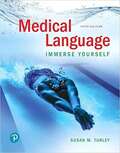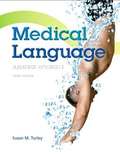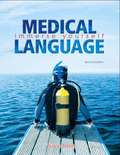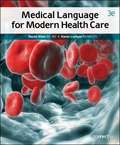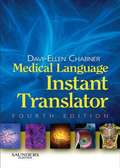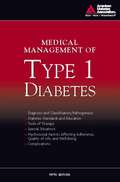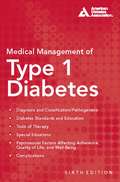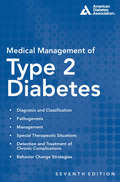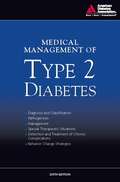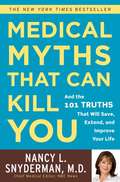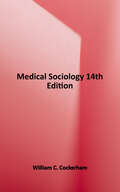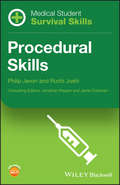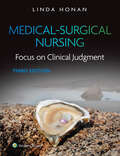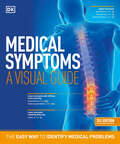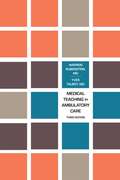- Table View
- List View
The Media and the Internet
by Peter Cole Peter Williams David Nicholas Helen MartinIts sheer functionality, connectivity and accessibility make the Internet an information force to be reckoned with. However, there is very little qualitative data on how the Internet is impacting upon information-seeking in the workplace. The Media and the Internet is a crucial piece of research into how journalists and other media workers are actually using this resource, based on interviews with more than three hundred journalists and media librarians. The findings are highly relevant to all those working in information intensive sectors.
Media Arts Education: Transforming Education Through Multimodal Cognition, Holistic Learning, and Techno-Embodiment
by Dain OlsenThis book introduces and explains the emergent and dynamic discipline of media arts education and its potentials for educational transformation. Through an examination of its theoretical principles, holistic pedagogy, adaptive instructional practices, and diverse creative capacities, it demonstrates how media arts education can lead to a more student-centered, interdisciplinary, and effective educational model.Chapters combine academic research and practical examples to give an in-depth understanding of media arts education as it exists within schools today, as well as its potential for educational advancement. Author Dain Olsen provides an instructional framework for the discipline, including its history, research from cognitive and learning science, pedagogical principles, and examples of instructional practice. The book discusses how media arts education promotes active, multimodal and inquiry-based learning, constructivist methodology, and transdisciplinary integrations. Media arts affords students the ability to construct and simulate anything imaginable, supporting their self-directed creative inquiry. Not only can they create the myriad of artistic media, they can use it in representing and applying any core content so that it becomes aesthetically interactive, malleable and understandable. Later chapters include examples of media arts educator practices with lesson descriptions, project sequences, and instructional narratives. The book argues that media arts education can form a multimodal, interconnective, and adaptive educational system that is more empowering, engaging, flexible, and equitable for all students’ academic success.This resource is an essential companion for media arts educators at all levels. As it covers integration across a variety of contexts, it will additionally benefit educators in the fields of visual and performing arts, career technical education, media studies, computer science, and STEM and STEAM education.
Media Law
by Dr S. R. MyneniThe author determined to write a textbook on Media Law an eminent Journalist about the frame and scheme of the book. The result is the outcome of this volume. The volume is based on the syllabus of Bar Council and different Indian Universities. No textbook writer can claim originality of thought as the author has to explain the prescribed topics based on given references. The reader of this textbook is advised to use this textbook for academic purposes.
Media Writer's Handbook: A Guide to Common Writing and Editing Problems
by George T. ArnoldAppropriate for media writing courses as either a primary or a supplemental text, Media Writer's Handbook is a primer for anyone who really wants to understand the grammatical and stylistic elements of good writing. Useful as a teaching tool in the classroom, this book also becomes a trusted reference resource for students and professionals. The sixth edition continues to identify and offer simple solutions for the most common language errors committed every day by mass media writers and broadcasters.
Mediating Interpersonal and Small Group Conflict
by Cheryl A. PicardThis is a guide to the theory and practice of mediation. It sets out a systematic approach to the use of mediation and to assuming the role of mediator. This book will be one of value to individuals interested in becoming mediators, to parties in conflict considering recourse to mediation to resolve issues, to students studying mediation as a dispute resolution alternative, to professionals who use mediation techniques in their day-to-day work, and to practising mediators who wish to expand and update their skills.
Mediatisation of Emotional Life (Routledge Research in Cultural and Media Studies)
by Katarzyna Kopecka-Piech Mateusz SobiechThis volume brings together an international team of authors to investigate a wide range of issues concerning the fundamental role of media technologies in shaping contemporary emotional life. Chapters explore key aspects of the mediatisation of emotional life, feelings and interpersonal relations: love, intimacy, loneliness, friendship, family relations, erotic, sexual and romantic experiences. The authors explain the key aspects of strong user–media relationships and human relationships based on media use and investigate problems such as the formation of identity based on social media, the role of communication applications and the effects of mobile and locative media on our relationships, as well as artificial intelligence, on our perception of our emotions. With a focus on new media, the book also draws on the scope of traditional media that express and shape emotions, taking into account the classic approaches to emotionality of messages from the perspective of film creators and recipients. This cutting-edge collection will be of interest to scholars and students of media and communication studies, especially digital media and new technologies, psychology, pedagogy, sociology of everyday life and cultural studies. Chapter 5 of this book is freely available as a downloadable Open Access PDF under a Creative Commons Attribution 4.0 license https://www.taylorfrancis.com/chapters/oa-edit/10.4324/9781003254287-8/love-jono-van-belle?context=ubx&refId=0deb9108-cd9e-4d98-b0b8-4f4ce1cce4c0 Chapter 10 of this book is freely available as a downloadable Open Access PDF under a Creative Commons Attribution 4.0 license https://www.taylorfrancis.com/chapters/oa-edit/10.4324/9781003254287-13/family-relations-tiina-r%C3%A4is%C3%A4?context=ubx&refId=2dec0bcd-cbba-493c-bbec-8cb5c6bd0086
The Mediator's Handbook
by Caroline C. Packard Eileen Stief Jennifer E. BeerThe popular The Mediator's Handbook presents a time-tested, adaptable model for helping people work through conflict. Extensively revised to incorporate recent practice and thinking, the accessible manual format lays out a clear structure for new and occasional mediators while offering a detailed, nuanced resource for professionals. Starting with a new chapter on assessing conflict and bringing people to the table, the first section explains the process step by step, from opening conversations and exploring the situation through the phases of finding resolution--deciding on topics, reviewing options, and testing agreements. The "Toolbox" section details the concepts and skills a mediator needs in order to: Understand the conflict Support the people Facilitate the process Guide decision-making Throughout the book, the emphasis is on what the mediator can do or say now, and on the underlying principles and core methods that can help the mediator make wise choices. Long a popular course textbook for high schools, universities, and training programs, The Mediator's Handbook is also a valued desk reference for professional mediators and a practical guide for managers, organizers, teachers, and anyone working with clients, customers, volunteers, committees, or teams. Jennifer E. Beer, PhD, mediates organizational conflicts, facilitates meetings, and offers related workshops, regularly teaching a negotiation course at Wharton (University of Pennsylvania). Caroline C. Packard, JD led Friends Conflict Resolution Programs for fifteen years and is an organizational conflict response specialist and mediator based in Philadelphia, Pennsylvania. Eileen Stief developed the mediation process presented in the Handbook, training a generation of mediators to work with community, multi-party, and environmental disputes.
The Mediatrician's Guide: A Joyful Approach to Raising Healthy, Smart, Kind Kids in a Screen-Saturated World
by Michael Rich, MD, MPHGain the confidence you need to raise a child well in the digital age.In this positive, science-based approach, Dr. Michael Rich addresses your questions and concerns about your childrens&’ screen time and media use. The Mediatrician&’s Guide empowers you to guide your family toward smart and healthy digital choices.Known as the &“Mediatrician&” due to his acclaimed work as a pediatrician, child health researcher, and children&’s media specialist, Dr. Rich presents a compassionate and encouraging look at the reality of growing up in a screen-saturated world. You won&’t find fearmongering here—just accessible explanations, case studies, and practical tips to help your kids thrive in a technology-rich environment and emerge as happy, well-informed, empathetic adults.Features include:Ask the Mediatrician: Questions and answers based on Dr. Rich&’s long-running advice column and podcastMedia Rx: Prescriptive content based on insights from the Digital Wellness Lab and the Clinic for Interactive Media and Internet DisordersYou Can: Straightforward instructions for what you can do to guide your child in the digital landscapeDigital Wellness Primer: A one-stop resource for actionable advice that you can customize for your family&’s specific needsBacked by evidence as well as decades of professional and personal practice, The Mediatrican's Guide will give you peace of mind and your kids much-needed tools to navigate the digital environment in a way that reduces the risks to their physical and mental health and their emotional and social development..&“A caring, wise, and joyful guide to the possibilities and the perils of our increasingly more digital existence.&”—Marlo Thomas, activist, actor, and author&“This book is a must-have and will soon become your best friend, full of daily tips and long-lasting wisdom.&”—Sanjay Gupta, MD,associate professor of neurosurgery, Emory, and chief medical correspondent, CNN
Medicaid Planning: From A to Z (2018 Ed. )
by K. Gabriel HeiserIf you wish to advise clients how to qualify for nursing home Medicaid while protecting their assets, this is the definitive book! Written by an elder law attorney with over 25 years of experience, this manual is the professional edition version of attorney Heiser's best-selling Medicaid Secrets book. This manual is geared toward attorneys, accountants, and financial advisors seeking up-to-date and accessible information on the Medicaid program rules as well as a complete analysis of available Medicaid asset protection techniques for their clients. Includes a summary of all income and asset rules for both married and single individuals, together with numerous examples and several case studies, which take the planner through the same thought processes that an experienced elder law attorney would go through when analyzing a real-life client's situation. The book includes tips on: how to title the home so the client does not lose it to the state; how to make transfers to family members that won't disqualify the client from Medicaid; how "Medicaid annuities" work to make assets "disappear" for Medicaid eligibility purposes; clever ideas for "spending down" assets; what to change in a client's will to save thousands of dollars if the spouse ever needs nursing home care; avoiding the state's reimbursement claim following the nursing home resident's death; and much more. The 2018 Edition has been expanded, revised, and completely updated to incorporate all changes in the law as of January 1, 2018, and includes two chapters on Veterans' benefits as well as a 39-page Ethics of Elder Law section. Completely annotated with all case citations and statutory references given in over 560 footnotes. Also includes full copies of relevant statutes and a sample filled-out Medicaid application, plus sample clauses for deeds, wills, powers of attorney, etc.
Medical Billing & Coding For Dummies
by Karen SmileyThe essential guide for medical billing professionals, updated for ICD-11 standards Medical Billing & Coding For Dummies will set you up for success in getting started as a medical biller and coder. To ensure data accuracy and efficient data processing, medical offices need professionally trained coders to handle records. This book provides prospective allied health professionals with everything they need to know to get started in medical billing and coding as a career. In addition to an introduction to the basics of medical coding, you'll get information on how to find a training course, meet certification requirements, and deal with government agencies and insurance companies. Learn about the standard practices in the medical billing industry and get up to speed on the ethical and legal issues you're likely to face on the job. This accessible guide is a great entry point—and a great refresher—for anyone interested in the medical billing and coding profession. Get a primer on your career options in the field of medical billing Learn coding practices for telehealth, viral outbreaks, and other emerging issues Update your knowledge of the changes between ICD-10 and ICD-11 coding systems Find training programs and explore your options for certification This Dummies guide is an accessible entry point for prospective professionals looking get a jump on their new career, and current professionals intent on staying up-to-date in this flexible and growing field.
Medical Language: Immerse Yourself
by Susan TurleyFor courses in medical terminology. <p><p> An immersive deep-dive into medical terminology Medical Language: Immerse Yourself is grounded in immersive language learning. Rather than memorizing vocabulary, students experience the sights and sounds of health care as they listen, speak, write, watch, examine, and think. A greater quantity and variety of exercises than any other text maximize opportunities to reinforce learning. The 5th edition retains its organization by medical specialty ― the way medicine is practiced in the real world. New to the 5th edition is a reorganization into 15 chapters, perfect for a 16-week course, and into five sections correlated with learning outcomes. Each section ends with new Practice Laps evaluating student competency and underscoring learning goals.
Medical Language: Immerse Yourself (Third Edition)
by Susan M. TurleyNow in its Third Edition,Medical Language has touched the lives of more people than any other medical terminology book. This intensely visual, powerfully relevant book is organized to promote exceptionally effective instruction and maximum student success. Fully updated to cover the field's newest terminology, this edition retains a deep focus on word building, and enhances teaching and learning in many ways -- including a state-of-the-art immersive online study experience. Its appealing, uncluttered design contains hundreds of rich images and plenty of white space for easy reading and note taking. Student learning is promoted through an unsurpassed quantity and variety of exercises, more colorful, interesting, and large illustrations, and - as requested by most instructors - an intuitive organization around medical specialties. In addition to content updates throughout, this edition is complemented by a brand new set of Dynamic Lectures: comprehensive audio/visual learning experiences narrated by the author.
Medical Language (2nd Edition)
by Susan M. TurleyMedical Language is a medical terminology text that truly immerses readers within the language of medicine, so that students can apply their vocabulary within a real-world context. As opposed to fostering rote memorization, this book engages students in an interactive learning experience that will give them a vital tool and inspire them to become truly proficient in medical language.
Medical Language For Modern Health Care (Third Edition)
by David Allan Karen LockyerMedical Language for Modern Health Care, third Edition, uses a Contextual Learning approach to introduce medical terminology within a healthcare environment. Chapters are broken into lessons that present and define terminology through the context of A & P, pathology, as well as clinical and diagnostic procedures. The text is setup in a way that covers one topic at a time, offering contextual content, tables, and exercises all in one place. Word Analysis and Definition Tables provide a color-coded guide to word parts and combining forms, as well as definitions and pronunciations. Now featuring newly added chapters covering Geriatrics, Oncology, Radiology, and Pharmacology. With unfolding patient case studies and documentation, students are introduced to various roles in the healthcare environment, illustrating the real-life application of medical terminology.
Medical Language Instant Translator
by Davi-Ellen ChabnerCommunicate more effectively when you use this pocket reference to medical terms and other useful information! Davi-Ellen Chabner's Medical Language Instant Translator, 4th Edition provides the tools you need to understand medical terminology. You can also access key information on common diagnostic tests and procedures, the top 100 prescription drugs, medical abbreviations, symbols, and acronyms - and much more. Based on Chabner's The Language of Medicine, this practical resource is ideal for any health care environment!Get quick, portable access to key medical terms and other need-to-know information. Decipher complicated medical terms by recognizing and finding the meanings of individual word parts. Distinguish between commonly misunderstood medical terms (e.g., ureter vs. urethra, or para vs. peri). Become familiar with common diagnostic tests and procedures and why they are ordered. Access information on medical abbreviations, symbols, acronyms, and professional designations. Understand the basics of surgical instruments, terminology, and technology. Identify the top 100 prescription drugs and their uses. Quickly access the top 100 diagnoses and associated procedures. Find the definitions of complementary and alternative medicine terms. Recognize specialized terms used in medical records. Review body systems anatomy with full-color illustrations.Adds a new section on eponyms -words based on or derived from a person's name. Adds a new section on Major Diagnostic Categories & Diagnosis-Related Groups (DRG). Includes updates corresponding to those in the Language of Medicine, 9th Edition, by Davi-Ellen Chabner.
Medical Management of Type 1 Diabetes
by American Diabetes Association Francine R. KaufmanA comprehensive resource for health care professionals that outlines the American Diabetes Association®'s recommended course of diagnosing and treating patients with type 1 diabetes. This comprehensive volume provides the basis for individualized, flexible, responsive treatment plans for patients with type 1 diabetes. It includes integrated approaches on blood pressure and lipid goals, proper nutrition, exercise, smoking cessation, and more. All based on the clinical practice recommendations of the American Diabetes Association®.
Medical Management of Type 1 Diabetes
by Francine R. KaufmanType 1 diabetes, formerly known as juvenile diabetes, is a complex disorder that requires a great deal of patient-guided self-care. In recent years, advances in diabetes treatment have dramatically shifted potential outcomes in the favor of the patient with diabetes. The challenge for health care professionals is to realize this potential through an individualized, flexible, and responsive treatment plan for patients with type 1 diabetes.Now in its sixth edition, Medical Management of Type 1 Diabetes offers health care providers the newest information and guidelines for the treatment of type 1 diabetes. Built on the foundation of multiple daily insulin injections and insulin pump therapy, this book guides health care providers in helping their patients continually strive for optimal blood glucose control. This new edition focuses on the latest molecular advances, new treatment methods, recent clinical trials, and the American Diabetes Association's Standards of Care. Key topics also include new insulins and administration protocols, advanced carbohydrate counting, and emphasis on continuing patient education.Individual sections address all of the topics in managing type 1 diabetes, including:Diagnosis and Classification/PathogenesisDiabetes Standards and EducationTools of TherapySpecial SituationsPsychosocial Factors Affecting Adherence, Quality of Life, and Well-BeingComplicationsEdited by Dr. Francine Kaufman, a widely recognized expert in the treatment of diabetes and of insulin therapy, and guided by the recognized authority of the American Diabetes Association's Standards of Care, Medical Management of Type 1 Diabetes is an essential addition to any clinician's library for the treatment and understanding of type 1 diabetes.
Medical Management of Type 2 Diabetes
by Charles F. BurantAs type 2 diabetes continues its rise in prevalence worldwide, there is an increasing need to study it and describe successful treatments. There are several options for treatment, including oral medications, diet and lifestyle modification, and insulin therapy. Knowing which method to select and how to apply it relies on several clinical guidelines that are updated every year by the American Diabetes Association.This new edition of Medical Management of Type 2 Diabetes provides care providers with the answers to their questions about implementing care. All of the contributors are experts in their fields, and they define the disease, including the progressive nature of type 2 diabetes; cardiovascular, microvascular, and neurological complications; care methodologies for special situations; and behavior change. All guidelines and standards have been updated with the latest developments in research, advances in medications and medical devices, and new understandings of how to effectively work with the patient.
Medical Management of Type 2 Diabetes
by Charles F. Burant American Diabetes AssociationThis clinical book for health care professionals features the most up-to-date approaches and protocols for diagnosing and treating patients with type 2 diabetes.Over 18 million people are living with diabetes and the majority have been diagnosed as type 2-a group particularly at-risk for cardiovascular complications. Health care practitioners will find this comprehensive resource for type 2 indispensable, providing the most up-to-date guidelines for diagnosis, treatment, glucose, and cardiovascular disease risk factor control as well as nutrition and exercise. Professionals will find the array of treatment options for all stages of cardiovascular disease particularly useful, as well as the behavior modification strategies.
Medical Myths That Can Kill You: And the 101 Truths That Will Save, Extend, and Improve Your Life
by Nancy L. Snyderman"Do you know what's really good for you?" In this age of countless miracle cures, it's vital to separate the myths that endanger your health from the medical truths you need. TRUTH: Unfiltered coffee can clog your arteries. TRUTH: Tossing and turning at night may shorten your life. TRUTH: Boring jobs can kill you. Get the information you need to revitalize your body, maintain your longevity, manage your health care, and possibly even save a life--yours.
Medical Sociology, Fourteenth Edition
by William C. CockerhamThe most thorough major academic textbook available, this classic text presents the most important research studies in the field. The author also integrates engaging first-person accounts from patients, physicians, and other healthcare providers throughout the text. A much greater number of first-person accounts and updated examples are added to the new fourteenth edition. Other updates include: - Coverage of Zika, Ebola, MERS, and updates on other pandemics - Expanded discussion of obesity as a disease - Coverage of the widening gap in life expectancy between the rich and the poor - New information on the decline of life expectancy among American white women, especially those who live in rural counties - New material on biomarkers, gene-environment interaction, and stress - Analysis of the role of the hidden curriculum in medical schools - Exiting the Affordable Care Act
Medical Student Survival Skills: Procedural Skills (Medical Student Survival Skills)
by Phil Jevon Ruchi JoshiMedical students encounter many challenges on their path to success, from managing their time, applying theory to practice, and passing exams. The Medical Student Survival Skills series helps medical students navigate core subjects of the curriculum, providing accessible short reference guides for OSCE preparation and hospital placements. These guides are the perfect tool for achieving clinical success.
Medical-Surgical Nursing: Focus on Clinical Judgment
by Linda HonanConfidently meet the demands of transitioning students into practice-ready nurses with Medical-Surgical Nursing: Focus on Clinical Judgment, 3rd Edition. Expertly curated by experienced clinician and nursing educator Dr. Linda Honan, this practical approach distills complex concepts down to need-to-know details through the perspective of practicing nurses, establishing a comprehensive foundation in medical-surgical nursing by way of the most commonly encountered conditions and situations. Extensive updates throughout this 3rd Edition broaden your students’ perspectives, cultivate their clinical judgment, and prepare them for success from the Next Generation NCLEX® to the day-to-day challenges of today’s medical-surgical nursing practice.
Medical Symptoms: The Easy Way to Identify Medical Problems (DK Medical Care Guides)
by DKFind home remedies and advice on illnesses and injuries! There are plenty of medical scenarios that can be identified and treated at home. This medical reference book takes you through the most common illnesses and injuries, their symptoms, locations in the body, how to treat them at home and when to seek professional medical attention.Inside this first aid guide, you&’ll find: • Easy-to-access visual symptoms guide, arranged by body part affected, working from head to toe • Intuitive entry-level helps the reader identify illness or locate injury quickly • Clear, simple illustrations of the associated anatomy help medical understanding • Conditions are listed in order of likelihood, with the most likely first, for speedy diagnosis • Symbols direct a reader to the appropriate form of medical help • Concise explanations of all the conditions featured in the diseases and disorders section • Updated to include Covid-19 Medical Symptoms is an easy-to-use visual symptoms finder and self-diagnosis book that will help you check out any health problem. Discover what an ailment or pain might be and what you should do. You&’ll find explanations of symptoms and diseases, clear human anatomy photographs, and suggested home care instructions. Once you&’ve narrowed it down, a cross-reference takes you to easy-to-follow descriptions of the condition at the back of the book. Potentially life-threatening situations symptoms that need urgent medical advice are clearly flagged. This is the perfect home medical guide for your family and is fully illustrated throughout.
Medical Teaching in Ambulatory Care, Third Edition
by Warren Rubenstein Yves TalbotA practical, hands-on resource for physicians in all specialties, Medical Teaching in Ambulatory Care is a guide on training medical students and residents in settings such as private practices and hospital clinics. Concise, engaging, and easy to follow, it is an ideal handbook for the busy practitioner looking to upgrade his or her teaching abilities.The authors cover basic education theory, individual teaching skills, strategies for evaluating trainees, and tips on working with challenging learners. Readers can follow along with the storyline of a fictional Dr. Smith, through whom the book provides practical examples that complement each theory, skill, and strategy presented.This new edition has been updated with key medical education theories that are now core to current approaches, expanded details on one-to-one teaching, and information on structured formats to use when reviewing patient encounters with learners. The authors also examine the impact of digital technology on medical education in office-based settings and provide tips on working with the new generation of learners who enjoy - and expect - instant access to information of all kinds.
